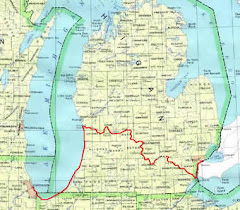The biggest battle of King Philip's War was the so-called Great Swamp Fight which took place near present-day Kingston, Rhode Island. It was an attack by colonial militia from Plymouth, Connecticut and Massachusetts Bay that killed about 300 Narragansett Indians on an island in the middle of what was known as the Great Swamp. Ordinarily the swamp was practically impenetrable but due to severe December weather the marshy ground was frozen and the English gained relatively easy access to the island. The Indian outposts retreated into their fort where they were followed by the English. The terrible battle which then began took place amidst ice and snow in underbrush and among fallen trees.
At first repulsed, the militiamen continued the assault, although with heavy losses. The Narragansetts, suffering many casualties, were driven from their fort into the swamp and woods, leaving the English with a complete, though costly victory. They had lost five captains and 20 men and had some 150 wounded.
Here is a quote from "Soldiers in King Phillip's War" by George Madison Bodge (1906):
"After the battle at the Narragansett Fort, several weeks of partial inactivity ensued, while both the English and the Indians were seeking to recover somewhat from the severe blow each had received. The forces of Massachusetts and Plymouth remained at Smith's garrison at Narragansett while Major Treat (Woodruff ancestor) with the Connecticut regiment returned to Stonington about December 28th. In the Treasurer's (Pratt ancestor John Talcott) account with Connecticut colony there is a charge "For billiting 40 wounded men 7 days", and as there is no other occasion when so many were wounded, it is fair to assume that the Connecticut forces did not retire before the 28th.
On January 14th the Council of Connecticut issued orders to Mr.John Brackett of Wallingford, and "Sergt." William Ward, "to go to New London and care for the wounded there, while Mr. Buckley goeth forth with the army". So it would seem that many of their wounded had been carried as far as New London."
"Sergt." William Ward was our ancestor William Ward from Fairfield. I believe he was a "Surgeon", not a Sergeant, sent to help the wounded. I have found other references which call him a surgeon.
He was the son of Andrew Ward, a Woodruff ancestor through the Shermans, and a Pratt ancestor through the Burr and Bartram lines. Andrew's genealogy and involvement with the Pequot War is covered in my Pratt/Woodruff History-Pequot War II Emaill of Noivember 16.
Wiiliam was the third child of Andrew and Hester Sherman, born about 1631. He married Deborah Lockwood, daughter of Sergeant Robert Lockwood, another one of our double ancestors. Sgt. Lockwood would have been in Watertown, Massachusetts, and of military age during the Pequot War, but I don't know whether or not he was involved.
I Googled "Colonial Medicine" to see if I could get a feel for what William's qualifications would have been and what his practice might have been like. Here are some extracts from "The History of Medicine in America":
"There were two physicians on the Mayflower. One was Miles Standish...He was an officer in the British army, a magistrate, an engineer, an explorer, an interpreter, a merchant and a physician (what a guy!)....Standish's formal education was in the military and, like many physicians of the time, he picked up medicine in his daily life and by watching other physicians. He was exceedingly brave and had no qualms about killing a threatening native...
Another physician among the Pilgrims was Dr. Samuel Fuller. We don't know much about his education or his skills as a physician, but we do know he died during the first smallpox epidemic to hit the colonies in 1633.
We also know that Dr. Fuller was a physician AND surgeon. Around this time most doctors were not surgeons and a lot of surgeons were not doctors. In fact, it was hard to tell a surgeon from a barber or at times a barber from a physician. They all practiced some sort of medicine.
The therapies practiced by these conventional physicians were bleeding, purging, either by emetic or enema, blistering and poisoning. Did I say poisoning? I meant prescribing medicines. The most popular medicine of the time being calomel, a form of mercury.
Previous to 1685, surgeons held little favor with anyone. If you wanted something cut off, you could attend a surgeon or a barber. If you wanted a little blood letting, you could attend a physician or a barber. Barbers did everything from cutting hair to pulling teeth to removing gallstones. All without anesthesia"
I hope our ancestor the surgeon didn't make the wounded worse.
NEXT: Trying to find out more about our ancestors in the war.
Emailed Dec. 5


No comments:
Post a Comment